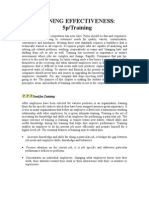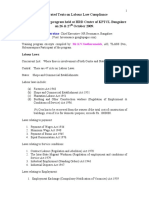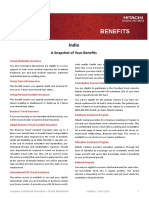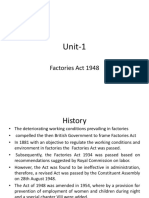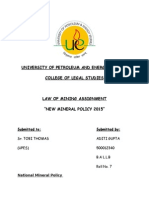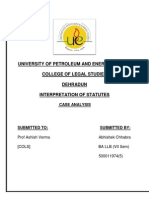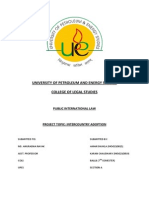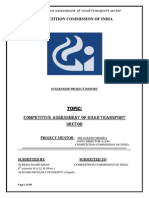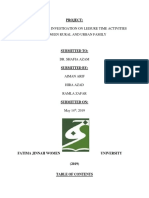Labour
Welfare
Factories Act 1948
�1851: Cotton Mill
1855: Jute Mill
-exploitation
-long hours of work
- Women and children
employed
1881: Indian
Factories Act
-at the instance of
the Lancashire
millowners
pressurised the
Govt to reduce
competition from
Indian Mills
- Protection to
children
1890- Factory
Commission
1891 : definition of
factory amended (50
persons), ltd. hours of
work, interval, power to
1911: Amendment
- hours of work :
12 for adults and 6
for children;
- women and
children prohibited
to work between 7
p.m. and 6 a.m
1934: New
Factories Act
- Hours of work: :
54
- max. hours of
work: 9
1922: Amendment
to implement ILO
Convention of
1919 on Hours of
Work
- 60 hours in a
week
- Children under
12 prohibited
Rege Committee
(Labour Party)
1948:Factories Act
- welfare, health,
safety,
cleanliness ,
overtime payment
1929: Royal
Commission on
Labour
(Depression)
Periodic
amendments till
1976, Amendment
of 1987 after
Bhopal Gas relating
to hazardous
�Constitutional Provisions
O DPSPs
O Concurrent List Entries
�Concurrent List of COI
O Entry 22. Trade unions; industrial and labour
disputes.
O Entry 23. Social security and social insurance;
employment and unemployment.
O Entry 24. Welfare of labour including conditions
of work, provident funds, employers' liability,
workmen's compensation, invalidity and old age
pensions and maternity benefits.
O Entry 25vocational and technical training of
labour.
O Entry 36. Factories.
�THE FACTORIES ACT ,1948
�Application & Object
O To the whole of India to all factories,
including factories belonging to
Central and State govt.
O Object: Regulate working conditions
of labour
O lays down the essential provisions
relating to working conditions,
hazardous processes, health, safety
and welfare of the workers and
provision and procedures for
penalties in case of contraventions of
provisions of the Act.
�Factorydefinition
O Black Law' Dictionary: includes all
buildings and premises wherein, or
within the close or curtilage of which,
steam, water, or any mechanical
power is used to move or work any
machinery employed in preparing,
manufacturing, or finishing cotton,
wool, hair, silk, flax, hemp, jute, or
tow..
�Definition under The
Act
OSec. 2m ofIndian Factories Act, Factory means "any
premises including the precincts Thereof
O i.Whereon ten or more workers are working, or were
working on any day of the preceding 12 months and in
any part of which is manufacturing process is being
carried on with the aid of power as is ordinarily so carried
on; or
O ii.Whereon twenty or more workers are working or were
working on any of the preceding 12 months and in any
part of which a manufacturing process is being carried on
without the aid of power pr is ordinarily so carried on.
O A factory shall not include a mine subject to the operation
of the Mines Act 1952 or a mobile unit belonging to the
armed forces of the Union, a railway running shed or
hotel, restaurant or eating places.
�INGREDIENTS ( of
factory)
i. If a premises is using power or working without the
aid of power the number of workers required to
constitute a factory differ as follows
a. With the aid of power- 10 or more workers
b. Without the aid of power- 20 or more workers
ii. A manufacturing process should be carried on
iii. Work should be carried on in precincts.
O The term "Precincts" inOxford Dictionaryis defined
as:
i. the area within the walls or perceived boundaries of
a particular building or place
ii. area in a town designated for specific or restricted
use, especially one which is closed to traffic
�MANUFACTURING PROCESS
O Transforming and transmitting electricity (not
conversion)
O Making of salt from sea water
O Preserving article in cold storage
O Sun cured tobacco leaves: moisture, strips, packed for
transport to main factory manufacturing cigarettes.
O Conversion of raw films into finished products
O Preparation of food stuffs and other eatables in the
kitchen of a restaurant as well as the use of
refrigerator
O Bidi making
O Cutting trees using axe and conversion into logs
�O Nagpur Electric Light & Power Co., ... vs Regional Director
Employees ... on 2 March, 1967 1967AIR 1364
O The High Court said:"This manufacturing process is carried on
by the Company not only in the building called the workshop or
the receiving station but over the whole area over which the
process of transmission is carried on including the sub- stations
where electricity is stored and supplied to the consumers by
further transmission lines. Thus every part over which this
process is carried on will be a factory within the meaning of the
Employees' State Insurance Act."
O We cannot accept this line of reasoning. It seems to us a
startling proposition that every inch of the wide areaover which
the transmission lines are spread is a factory within the
meaning of s. 2(12). "A factory must occupy a fixed site", see
Halsbury's Laws of England, 3rd ed., Vol. 71 ,art. 15, p. 15. The
company's factory has a fixed site.
�WORKER
S.2(l)
O "worker" means a person employed, directly or
by or through any agency (including a
contractor) with or without the knowledge of the
principal employer, whether for remuneration
or not, in any manufacturing process, or in
cleaning any part of the machinery or premises
used for a manufacturing process, or in any other
kind of work incidental to, or connected with, the
manufacturing process, or the subject of the
manufacturing process but does not include any
member of the armed forces of the Union.
�O Apprentice
O Payment in kind
O Watchmen
O Independent contractors
O Control & supervision
O Shankar Balaji v. State of
Maharashtra AIR 1962 SC 517
�Occupier
S.2(n)
O person who has ultimate control over the affairs of the factory .
Provided thatO (i) in the case of a firm or other association of individuals, any one
of the individual partners or members thereof shall be deemed to
be the occupier;
O (ii) in the case of a company, any one of the directors shall be
deemed to be the occupier;
O (iii) in the case of a factory owned or controlled by the Central
Government or any State Government, or any local authority, the
person or persons appointed to manage the affairs of the factory
by the Central Government, the State Government or the local
authority, as the case may be, shall be deemed to be the occupier;
O Provided further that in the case of a ship which is being repaired,
or on which maintenance work is being carried out, in a dry dock
which is available for hire-
�O Must not be equated with the owner
O Touchstone : ultimate control of the
factory and not the company
O IOC v. Chief Inspector of Factories
AIR 1998 SC 2456
O Knoria Jute Industries Ltd. & others
v. ESIC
(2003) I L.L.J. 364(Cal)
�O S.6: registration & license
O S.7A: General duties of the occupier
�Hotels: whether a
factory
O Lal Bovta Hotel Bakery Mazdoor Union v. Ritz
Private Ltd. India 2007 (113) FLR 568.
O In case of a co., its only one of the directors
of the co. who can be an occupier and the
co, cannot nominate any other employee to
be the occupier of the factory: Container
Corporation of India Ltd. v. Lt. Governor,
Delhi (2003) 98 FLR 653: 2002 LLR 1068
O Indian Oil Corp. v. Labour Commissioner AIR
1998 SC 2456: Central govt .is the occupier
of IOC.
�HAZARDOUS PROCESS
S.2(cb) "hazardous process" means any process or
activity in relation to an industry specified in the First
Schedule where, unless special care is taken, raw
materials used therein or the intermediate or
finished products, bye products, wastes or effluents
thereof would-(i) cause material impairment to the health of the
persons engaged in or connected therewith, or
(ii) result in the pollution of the general environment:
Provided that the State Government may, by
notification in the Official Gazette, amend the First
Schedule by way of addition, omission or variation of
any industry specified in the said Schedule;
�Chp IV-A: Dealing with HP
Site Appraisal Committee (S.41-A)?
- for advising the State Govt. to consider
applications for grant of permission for the initial
location of a factory .
Duty of occupier:
- Compulsory disclosure of information.(41-B)
- maintain medical records (41-C)
- hire competent persons for handling (41-C)
- provide facilities to protect workers. (41-C)
- provide medical examination (41-C)
- set up Safety Committee (workers +mgmt) (S.41-G)
Right of workers: to warn abt. Imminent danger (41-H)
�Welfare of workers
O S.42: Washing facilities for workmen
O S.43: Storing and drying clothing facilities.
O S.44: Facilities for sitting, opp. For rest
O S.45: First aid appliances.
O S.46: Canteens: >250 workers
- whether workers of canteen =workers of
establishment ?
- depends on how obligation to set up canteen was
discharged : by direct recruitment or through a contractor
Harishankar Sharma & Ors v. Artificial Limbs
Manufacturing Corp. and Ors. (2002) L.L.J. 237(S.C.)
S.47: Shelters, rest rooms and lunch rooms
S.48: Creches: >30 women workers, for children below 6
yrs.
S.49: Welfare officer for >500 workers
�Working hours
O S.51: MAX. 48 hours a week
O S.52: Weekly holidays- first day of the week
O S.54: Daily hours - >9 hours a day
O S.55: Intervals for rest- no worker shall work for
more than 5 hours before he has had 1 hr. rest.
O S. 57: Night shifts
O S.59: Extra wages for overtime
O S.66: Restrictions on employment of women- no
women shall be required/allowed to work in any
factory except between 6.a.m & 7 p.m.
O S.71: Working hrs. of children: not for more than
4.5 hrs a day & during the night.(10 p.m.-6 a.m.)
�Employment of Young
Persons
O S.67: No employment of children
below 14 yrs.
O S.68: For non adults: certificate of
fitness reqd.
O Chp. X: Penalties
�Authorities
O Chief Inspector (app. By State govt.)
O Add. Chief Inspector
O Joint Chief Inspector
O Deputy Chief Inspector
O Inspector: Distt. Magistrate in each
distt.
O If more than 1 inspector: powers
defined by state govt.
O Powers: S.9: examination, inquiry,
seizure,

